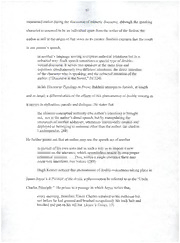
Christiane Rochefort and the dialogic : voices of tension and intention PDF
Preview Christiane Rochefort and the dialogic : voices of tension and intention
CHR1STIANEROCHEFORTANDTHEDIALOGIC: VOICESOFTENSIONANDINTENTION BY PAMELAFRIESPAINE ADISSERTATIONPRESENTEDTOTHEGRADUATESCHOOL OFTHEUNIVERSITYOFFLORIDAINPARTIALFULFILLMENT OFTHEREQUIREMENTSFORTHEDEGREEOF DOCTOROFPHILOSOPHY Copyright2000 by PamelaFriesPaine Dedicatedinlovingappreciationtomyhusband,JamesRobertPaine,forallthe manymonthsofpatience,encouragement,determinedoptimism,andfinancial support,thatpermittedthesuccessfulcompletionofthisambitiousproject. ACKNOWLEDGEMENTS IextendmysincerethankstoCarolMurphy,whochairedmycommitteeandwho providedvision,guidance,professionalexpertise,andgentleencouragement throughouttheresearchandwritingprocess.Myappreciationextendstotheentire, distinguishedcommitteewhosemanyhoursofcarefulreadingandinsightful suggestionscontributedtothesuccessfulcompletionofthisproject.Iamgratefulto theUniversityofFlorida'sDepartmentofRomanceLanguagesandLiteraturesfor providingastimulatingacademicenvironmentthatnurturedmyintellectual developmentandforofferingfinancialsupportthroughteachingassistantshipsand tuitionwaivers.IalsowishtoexpressmyappreciationfortheDissertation FellowshipprovidedtomethroughgenerousfundingfromGaryandNietyGersonto theUniversityofFlorida'sCollegeofLiberalArtsandSciences. TABLEOFCONTENTS page ACKNOWLEDGMENTS iv ABSTRACT vi CHAPTERS 1THETHEORETICALQUESTIONOFVOICEINLITERATURE 1 Notes 29 2OVERVIEWOFROCHEFORT'SWRITINGCAREER 31 Notes 56 3ROCHEFORT'SEARLYNOVELS 57 Notes 106 4ROCHEFORT'SMIDDLEPERIOD 109 Notes 158 5ROCHEFORT'SMATUREFICTION 161 Notes 222 CONCLUSIONS 226 REFERENCES 233 BIOGRAPHICALSKETCH 243 AbstractofDissertationPresentedtotheGraduateSchool oftheUniversityofFloridainPartialFulfillmentofthe RequirementsfortheDegreeofDoctorofPhilosophy CHRISTIANEROCHEFORTANDTHEDIALOGIC: VOICESOFTENSIONANDINTENTION By PamelaFriesPaine December2000 Chair:Dr.CarolJ.Murphy MajorDepartment:RomanceLanguagesandLiteratures Thisdissertationexaminesthenovelisticfictionof20th-centuryFrench writerChristianeRochefort.Itsthesisisthatanunderstandingofthepresenceand functioningofvoiceinRochefort'snarrativeisessentialtodiscerningmeaninginher textsandtoappreciatingthecomplexityandsubtletyofherart.AlthoughRochefort hasnotyetbeendeemedamajorwriter,oneasimportantasSarrauteorDuras,for example,thisanalysisoriginatesinaconvictionthatherworkmeritsmorestudyand recognition.Whileliteraryprizesdistinguishherearlyfictionasthematically significant,arelativepaucityofpublishedscholarlyanalysisreferencingherlater workfurthermotivatedthepresentresearch. Thisdissertationextendstheexistingbodyofcriticalanalysissurrounding Rochefort'sfictionandpointsoutthat,inadditiontothethematicinterestofher work,thecomplexityofhernarrativetechniquebringsimportantcontributionstothe artisticdevelopmentofthenovelasagenre.Inparticular,bycloseexaminationof voiceinhernovelsonecandeconstructverbalmasksandsubtlemanifestationsof multipleconsciousnessamongdiversesocialspeechtypesandheterogeneous perspectives. VoiceisanessentialstructuralelementthatRochefortappliedinher writing.Theintroductionprovidesanoverviewofthecriticalquestionofvoiceby definingtermsandoutliningmajorcontributionstoitstheory.Notingthat Rochefort'sfictioniscompatiblewithMikhailBakhtin'sdefinitionofthenovelasthe artisticorganizationofdiverseindividualvoicesandsocialspeechtypes,thisstudy drawsparticularsupportfromBakhtiniantheoryandterminology.Bothnovelistand theoristenvisionthenovelasadialogicandpolyphoniccomplexofvoiceswithina social,historical,andculturalcontext.Thisanalysisdemonstratesthat,infact, Rochefort'spersonalvisionandindividualartistryresideintherefined,transformed andreconstitutedfictionalrepresentationofthelanguage,attitudes,tensions,and intentionsdiscernablewithinthedialogicinteractionofherfictionalnarratorsand characters. ThisstudydividesRochefort'sfictionalworkintothreeperiodsinorderto differentiatehernovelsboththematicallyandstylistically.Closereadingofthe novelsineachgroup,withparticularfocusonthefunctioningofvoice,offersanew approachtothewriter'sfiction.Thisstudyalsoprovidesscholarlyanalysisofseveral textsthathave,untilnow,remainedobscure,misunderstood,andunappreciated. CHAPTERONE THETHEORETICALQUESTIONOFVOICEINLITERATURE "Etl'ecrituren'est-cepasuneconversation? (ChristianeRochefort,Conversationssansparoles,25) Voicesofallkindsresonateinbothproseandpoetry:voicesofcharacters, narrators,andauthors;voicesofhistory,societyandotherliterature;voicesquoted, mimicked,parodiedandparaphrased.Voicehaslongbeenanimportant considerationintheappreciationandanalysisofliterature.Asacriticalconcept,the notionofvoicehashadvariedandinconsistentusage.Thetermhasbeenusedto differentiateamongcharactersspeaking,narratorsrecounting,andevenauthors' styles.Generallyspeaking,voicehasbeenusedasametonymforthehuman presenceevokedthroughthereadingofapoemorstory.Oftenrepresentinga consciousnessassertingitselfintothatofothers,voicecanfigureimportantlyinthe formulationofidentityor,inmoderntheoreticalterms,ofsubjectivity. Thedesiretohaveavoice,toclaimthedominantpositionofspeakingsubject hasbeennotonlyaprominentthemeinmuchoftwentieth-centuryliterature,buta motivationformanyofthecentury'snumerouswriters.Togainavoiceistobecome empoweredsymbolically.Thecentralityofvoiceinliteratureisevidencedbythe numberofquestionsappurtenanttonarratologyingeneralthattheissueofvoice inevitablyraises(suchasintention,pointofview,rhetoric,reception,time,place, truth,reliability,andauthority,forexample).ChristianeRochefort'snovelistic fictionforegroundstheinterplayofmultiplevoiceswhosedialogicinteractionforms thebasisforthecreationofnarrativetensionandinterestinhernovels.Herwork, then,isideallysuitedforanalysisthroughastudyofthepresenceandfunctionof thosefictionalvoices. RecognizingvoiceasanessentialstructuralelementthatChristiane Rocheforthashighlightedinherwriting,thefollowingchaptersexploreitsdifferent manifestationsinherworkandattempttodetermineitsnatureandfunctioning.The objectiveofthestudyistoidentifycategoriesofvoicepresentinRochefort'swriting andtodiscoverthetensionsandintentionalitiesinherentinthosevoicesthat,through theirdialogicinterfacing,contributetolevelsofmeaningimmanentinhernarrative. Literature,oftenthesiteofadiscourseofopposition,canfunctiontoincrease awarenessofthoseminorforcesandvoicesoperatingparadoxicallywithinthe dominant.Rochefort'skeeninterestinthesubversivepotentialoflanguage, combinedwithherattentiontomarginalizedindividualsandgroups,makesher narrativefictionespeciallyappropriateforanin-depthstudyofsomeofthose insistentvoiceswhich,bytheirtenaciousdeterminationtobeheard,mayspark futuresocial,political,andartisticchange.Thechallengeforthereaderthenliesin carefulreadingandanalysisofthediscoursethatisbeingused.AsMichelFoucault aptlystated,"thequestionisultimately:whatwassaidinwhatwasbeing smdT'(ArchaeoIogyofKnowledge,40). Figuringprominentlyandcontroversiallyamongtheconsiderablenumberof womenwritingandpublishinginthelatterhalfofthetwentiethcentury,Christiane Rocheforthasleftalegacyofcomplexandchallengingtextsthatmeritattentionboth forherstylisticsandforhertreatmentoftheme.Despiteprizesofdistinction awardedtoherworkbyvariousFrenchliteraryagencies,anddespitegrowing interestinherearlybooksasapointofdepartureforFrenchculturalstudies, Rochefort'sartisticcontributionremainslargelyunappreciated.Theexaminationof herworkinthisstudyfocusesonnarrativetechniquewithparticularattentiontothe treatmentandsignificanceofvoiceinherwritingprojectand.inturn,the contributionofherworktotheFrenchliterarycanon. Althoughtheoriesofvoicemaybestudiedfromapsychologicalperspective, Ichosetofocusmyanalysisonnarratologicalissues,particularlythenotionofvoice asconceivedbyMikhailBakhtin.Specifically,attentionisgiventothepluralityor layeringofvoice,itssocially-codednature,anditsdialogicfunctioningwithinthe text. Becauseofthenumerousscholarswhohavecontributedtoexplainingthe complexitiesofnarratologyinfictionalwriting,ahighlyspecializedlexiconhas evolved.BeforebeginningtheexaminationofvoiceinChristianeRochefort's fiction,itwouldbeuseful,then,toreviewthedevelopmentoftheconceptofvoiceas anarratologicaldeviceinordertoclarifyandpositiontermstobeusedinthecourse ofthediscussion. Asacategoryinpoetics,theconceptofvoicehasitsrootsinclassicalGreek aesthetics.InTheRepublic,Socratesusesthetermsdiegesisandmimesisto distinguishwhetherthepoetisspeakinginhisownvoice,isimitatingthevoiceof another,orismixingthetwomodes.Mimesisreferstotheimitationorquotingof speech,whereasdiegesisreferstodirectrecountingortellingofthenarrative.
